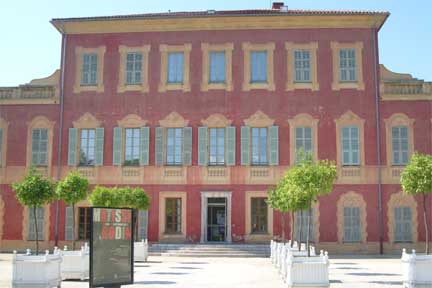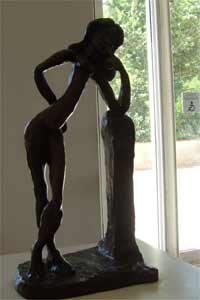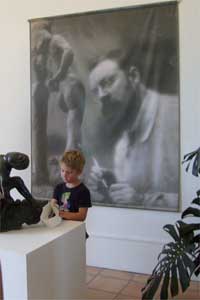Matisse and Rodin
by Carly Jane Lock
Article published on the 2009-08-28 Latest update 2009-08-28 13:03 TU

The Matisse Museum in Nice's Cimiez park is the perfect example of a Mediterranean-style villa, with its red-ochre façades.
(Photo: Carly Jane Lock/RFI)
Henri Matisse and Auguste Rodin were a generation apart, the sculptor was 29 years Matisse’s senior. But both were ahead of their time and are consequently among France’s top-echelon artists. The pair come head-to-head in a two-part exhibition at the Matisse Museum in the southern French city of Nice through the end of September. Act II of Matisse & Rodin begins on 23 October in Paris at the Hotel Biron, home to the Rodin Museum since 1919.
The Matisse & Rodin show in Nice mixes sculptures and sketches from the Matisse Museum’s permanent collection, while drawing widely on works owned by public and private collectors from France and abroad.
“Drawing is putting a line (a)round an idea.” --Henri Matisse.
By using a thematic approach, Matisse & Rodin examines points of convergence and divergence in the sculptural and graphic work of the two masters. It aims to explore Matisse's sculpture and drawings and, from the perspective of Matisse's art, to see Rodin in a new light.
The museum’s Chief Curator, Marie-Thérèse Pulvenis de Seligny says you do not need to come to this show armed with a lot of knowledge.
“Visitors should come with an open mind,” she says.
Free interpretation over “cookie-cutter” comparisons between the two artists’ work, is she is trying to convey.
Greeting visitors in the foyer, a handful of pieces by Maillol, Bourdelle, Matisse and Rodin spotlight elements of the creative process common to sculptors of the early 20th century.
In an adjoining room, works by Michael-Angelo and Barye illustrate Matisse and Rodin‘s shared passion for the classical tradition of Greek and Roman art.
“There are unknown forces in nature; when we give ourselves wholly to her, without reserve, she lends them to us; she shows us these forms, which our watching eyes do not see, which our intelligence does not understand or suspect.”
--Auguste Rodin.
Contemplating splendid sculptures in a cool room on a sweltering afternoon on the French Riviera is a perfectly lazy pursuit, marred only slightly by a feeling of uneasiness brought on by all the industry and slog the two artists put into their draughtsmanship.
“Art is contemplation. It is the pleasure of the mind which searches into nature and which there divines the spirit of which Nature herself is animated.” --Auguste Rodin.
“Creativity takes courage.” --Henri Matisse.
One room looks at Matisse and Rodin’s icy first encounter in 1899. The displays and gallery leaflet reveal that some years after the two artists met, Matisse admitted that he had been disheartened by Rodin's cutting remarks about his drawings.
Despite their rocky start, Matisse frequently referred to Rodin in his observations, acquiring one of the sculptor’s early works in plaster: a bust of the French journalist, politician and writer Rochefort.
Like his elder, Matisse shunned stone for more malleable materials like bronze and marble. Non-academic figure poses were also part of their respective stylistic vocabularies.
Matisse’s sculpted female nudes—compilations of disproportional or simplified limbs, and distorted masses—distil the Expressionist spirit that characterised early 20th century sculpture in France.
“Exactitude is not truth.” --Henri Matisse.
At the end of the exhibition it becomes clear that Matisse’s early graphic and sculptural œuvre was a chip off the old block.
But perhaps the fresh setting that Matisse & Rodin part II offers will provide a clearer picture of how much of the painter’s prodigious talent as a sculptor is owed to Rodin.
Exhibition Curator Nadine Lehni at the Rodin Museum says the second part of the exhibition will emphasis graphic work, particularly Matisse’s gouaches coupees and cut paper compositions, which the artist referred to as “carving of the colour”.
Dance and its influence on both masters’ modelling techniques will also be a key theme running through the retrospective in Paris. Lehini says the show moves away from Matisse’s fascination with Rodin, by looking at the artists who haunted Matisse's later sculpture after Rodin‘s death in 1917.
Matisse & Rodin at the Matisse Museum in Nice until 27 September, then 23 October-28 February 2010 at the Rodin Museum in Paris.
Culture
Cracking skulls!
2010-02-15 12:35 TU
France's gothic avant-garde
2010-02-13 15:16 TU
Winter sounds warm up French jazz fans
A tribute to trumpeter Don Cherry at a Free Jazz showcase festival outside of Paris.
2010-01-31 11:55 TU
Trance on a trapeze
2010-01-30 12:41 TU
Retro Mobile - classic car exhibition
260,500 euros for rusty old car found at bottom of lake
A rusty old Bugatti, which spent years at the bottom of a Swiss lake, sold for 260,500 euros at the Retro Mobile classic car exhibition on Saturday. Other more lovingly-restored pristine examples are exciting enthusiasts from across the world in a special anniversary event at Porte de Versailles in Paris.
2010-01-23 20:21 TU
France's changing face looks east
2010-01-22 16:17 TU
Putting art on film
2010-01-20 13:09 TU
What sex is a coffee bean, where does the aubergine come from?
2010-01-08 16:08 TU
Cocteau Twin flying solo
2010-01-06 16:43 TU
A taste of Nordic filmmaking in Paris
Ciné Nordica 2009 at Paris’s Panthéon cinema showcases filmmaking from Scandinavia. So what makes Nordic film different from the rest?
2009-12-22 17:15 TU
Listen
Culture in France: Matisse & Rodin
2009-08-28
















